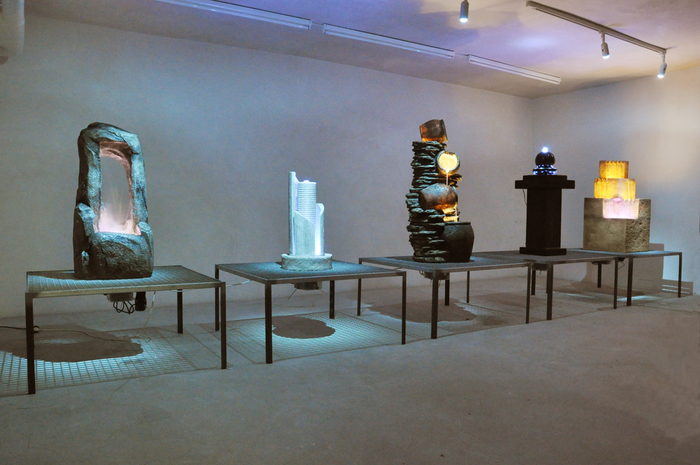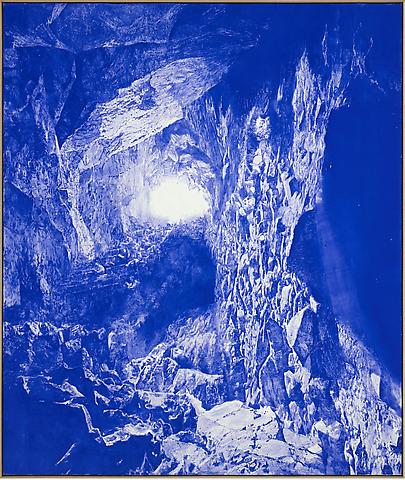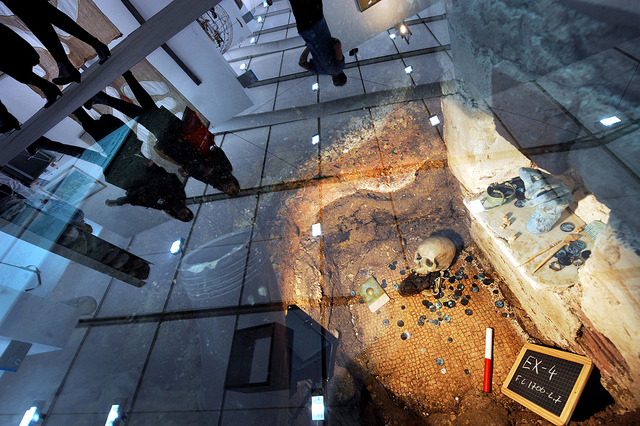Frieze Art Fair, Regent's Park | reviews, news & interviews
Frieze Art Fair, Regent's Park
Frieze Art Fair, Regent's Park
Frieze frames itself with humour and innovation
Contemporary art can, unsurprisingly, become dated pretty quickly – the clue is in the name. Another of Damien Hirst’s mirrored cabinets of pills or of Gavin Turk’s piss-takes of Andy Warhol at the Frieze Art Fair in Regent’s Park is hardly the sort of sight which will enthuse hardened art-gallery goers.
But then that’s not the point of art fairs – the major ones like Frieze, Basel and Miami, anyway: they codify established trends, reinforce hierarchies. Even the layout of the galleries shows you this, with heavyweights like Gagosian and Gladstone hogging prime positions, with everyone else satellites caught in their orbit.
But this is something Matthew Slotover and Amanda Sharp, the founders of Frieze, are evidently aware of, because in the past couple of years, Frieze has been rejigging the natural order, promoting the unconventional and the daring, the green shoots and the newly flowering – as you would hope. The prime example of that was last year’s innovative section, Frame, where young galleries put on a single-artist show; it returns this year even more surprising than before.
Shannon Ebner’s display at Altman Siegel of San Francisco was the first thing I encountered in Frame, and it was arresting: Ebner cuts out letters and photographs them against a particular real-world background. Here were four six-foot high photos with AGITATE splayed across them, the letters seemingly made from cardboard and leaning against a domestic brick wall. The radical exhortation jarred against the deadly cosiness of home, even though this contrast is initially conjured subtly.
 Easily the least explicable Frame show is by Aids-3D at Gentili Apri of Berlin. Indeed, it took the gallerist at least two goes to convey quite why nine hideous ornamental water features were hooked up to unseen computers and a screen solving a scientific problem, all hidden in darkness behind a curtain. (Right is an earlier installation of this work.)
Easily the least explicable Frame show is by Aids-3D at Gentili Apri of Berlin. Indeed, it took the gallerist at least two goes to convey quite why nine hideous ornamental water features were hooked up to unseen computers and a screen solving a scientific problem, all hidden in darkness behind a curtain. (Right is an earlier installation of this work.)
But once he had, in words of two syllables or fewer, the moral hollowness represented by the chintzy magic of the fountains was evident, their domesticity (a theme emerges) selfish and vain in the face of global problems. This may sound hectoring, but the display itself is so entrancing, the soft rush of water and the hum of computers and the darkness of the room, that you are seduced, thus reiterating the moral quandary.
This softness, while not entirely replicated throughout the fair, is much more evident in the post-recessionary Friezes than those pre: I don’t think I spotted a single gaudy Murakami (for which we ought to give thanks). The old order may still predominate, but it has toned its presence down.
 The picture everyone was talking about was at Gagosian – one of Mark Tansey’s monochrome scenes which throws up something new each time you stare at it from a different angle. What at first sight is a view upwards through a cavern is, by tilting your head to the right, men sitting by a lake, and further rotation gives further surprise. Heads are hidden in drifts of deep blue, bodies in patches of white. It was on sale for $2 million, and so confident were Gagosian of getting it, they had already turned down $1.5 million.
The picture everyone was talking about was at Gagosian – one of Mark Tansey’s monochrome scenes which throws up something new each time you stare at it from a different angle. What at first sight is a view upwards through a cavern is, by tilting your head to the right, men sitting by a lake, and further rotation gives further surprise. Heads are hidden in drifts of deep blue, bodies in patches of white. It was on sale for $2 million, and so confident were Gagosian of getting it, they had already turned down $1.5 million.
This says something important about the art market right now. Everything apart from the very top of contemporary art has experienced a severe correction, as one dealer put it to me, but $15 million paintings will still go quickly. As with most destructive phenomena, the strong survive reinforced, and thus what Frieze this year exhibits is a return to quality, with international money still following it freely, but a change in attitude from previous brazen salesmanship and craftsmanship to greater discretion of tactics and of works today.
One thing Frieze has never had a problem with is poking fun at itself. It does not defend its dignity to the death as Art Basel does, and in fact encourages us to explore and expose the whole spectacle of its freewheeling art-and-money marketplace. Take this year’s winner of the Cartier Award, Simon Fujiwara, who has “excavated” Roman ruins underneath the marquee. As well as its absurd conception, the contents of Frozen City give the art world a thorough going-over. (One "discovery" is below.)
 In one pit, an artist’s skeleton has been discovered, a spike through his head, and a series of identical self-portraits unearthed nearby. The faux-naivety of the signage mocks the pretentious panels next to artworks in galleries (it tentatively suggests these self-portraits might have been called “editions”, the standard modern term, as if the concept were foreign to today), while the portrait is a copy of the famous Roman ones from the Fayum in Egypt. Perhaps, the signage offers, he was killed by rival artists jealous at his success. There are pits throughout the marquee, and each is a witty contribution to a project which nips at the hand that feeds it.
In one pit, an artist’s skeleton has been discovered, a spike through his head, and a series of identical self-portraits unearthed nearby. The faux-naivety of the signage mocks the pretentious panels next to artworks in galleries (it tentatively suggests these self-portraits might have been called “editions”, the standard modern term, as if the concept were foreign to today), while the portrait is a copy of the famous Roman ones from the Fayum in Egypt. Perhaps, the signage offers, he was killed by rival artists jealous at his success. There are pits throughout the marquee, and each is a witty contribution to a project which nips at the hand that feeds it.
And that is what makes Frieze the cavalcade of art and delight, money and power that it has become: even when most galleries are safely within their comfort zones, pushing the same shocks and giggles as ever, the fair has enough confidence to allow its simultaneous subversion. This year, as much as an art fair can, Frieze continues to help the contemporary scene to renew itself.
- The Frieze Art Fair runs until Sunday 17 October
- Read Sarah Kent on why Frieze is bad for art on theartsdesk
Explore topics
Share this article
more Visual arts
 Eye to Eye: Homage to Ernst Scheidegger, MASI Lugano review - era-defining artist portraits
One of Switzerland's greatest photographers celebrated with a major retrospective
Eye to Eye: Homage to Ernst Scheidegger, MASI Lugano review - era-defining artist portraits
One of Switzerland's greatest photographers celebrated with a major retrospective
 Stephen review - a breathtakingly good first feature by a multi-media artist
Melanie Manchot's debut is strikingly intelligent and compelling
Stephen review - a breathtakingly good first feature by a multi-media artist
Melanie Manchot's debut is strikingly intelligent and compelling
 Fantastic Machine review - photography's story from one camera to 45 billion
Love it or hate it, the photographic image has ensnared us all
Fantastic Machine review - photography's story from one camera to 45 billion
Love it or hate it, the photographic image has ensnared us all
 Yinka Shonibare: Suspended States, Serpentine Gallery review - pure delight
Weighty subject matter treated with the lightest of touch
Yinka Shonibare: Suspended States, Serpentine Gallery review - pure delight
Weighty subject matter treated with the lightest of touch
 Jane Harris: Ellipse, Frac Nouvelle-Aquitaine MÉCA, Bordeaux review - ovals to the fore
Persistence and conviction in the works of the late English painter
Jane Harris: Ellipse, Frac Nouvelle-Aquitaine MÉCA, Bordeaux review - ovals to the fore
Persistence and conviction in the works of the late English painter
 Sargent and Fashion, Tate Britain review - portraiture as a performance
London’s elite posing dressed up to the nines
Sargent and Fashion, Tate Britain review - portraiture as a performance
London’s elite posing dressed up to the nines
 Zineb Sedira: Dreams Have No Titles, Whitechapel Gallery review - a disorientating mix of fact and fiction
An exhibition that begs the question 'What and where is home?'
Zineb Sedira: Dreams Have No Titles, Whitechapel Gallery review - a disorientating mix of fact and fiction
An exhibition that begs the question 'What and where is home?'
 Yoko Ono: Music of the Mind, Tate Modern review - a fitting celebration of the early years
Acknowledgement as a major avant garde artist comes at 90
Yoko Ono: Music of the Mind, Tate Modern review - a fitting celebration of the early years
Acknowledgement as a major avant garde artist comes at 90
 Unravel: The Power and Politics of Textiles in Art, Barbican review - the fabric of dissent
An ambitious exploration of a neglected medium
Unravel: The Power and Politics of Textiles in Art, Barbican review - the fabric of dissent
An ambitious exploration of a neglected medium
 When Forms Come Alive, Hayward Gallery review - how to reduce good art to family fun
Seriously good sculptures presented as little more than playthings or jokes
When Forms Come Alive, Hayward Gallery review - how to reduce good art to family fun
Seriously good sculptures presented as little more than playthings or jokes
 Entangled Pasts 1768-now, Royal Academy review - an institution exploring its racist past
After a long, slow journey from invisibility to agency, black people finally get a look in
Entangled Pasts 1768-now, Royal Academy review - an institution exploring its racist past
After a long, slow journey from invisibility to agency, black people finally get a look in
 Barbara Kruger, Serpentine Gallery review - clever, funny and chilling installations
Exploring the lies, deceptions and hyperbole used to cajole, bully and manipulate us
Barbara Kruger, Serpentine Gallery review - clever, funny and chilling installations
Exploring the lies, deceptions and hyperbole used to cajole, bully and manipulate us

Add comment